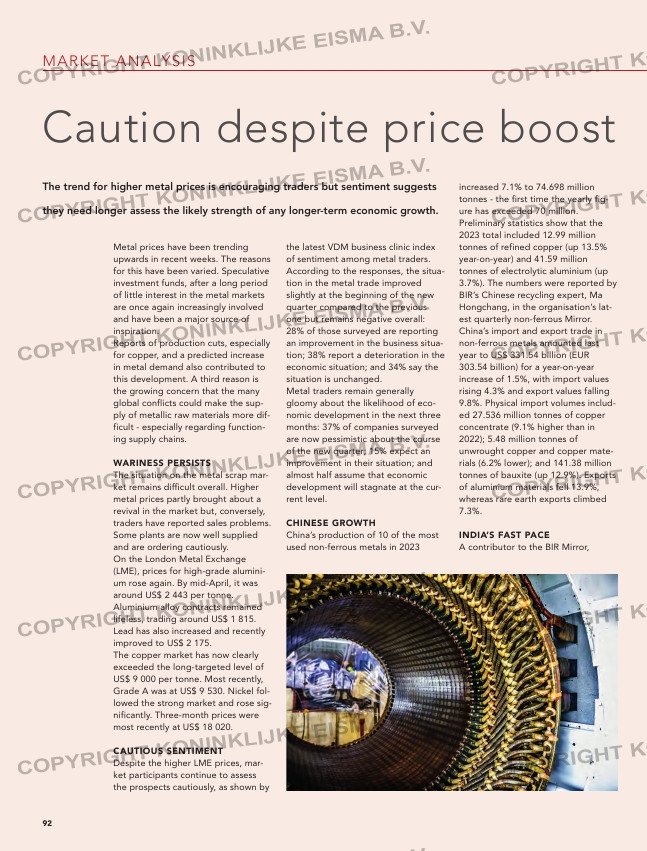Page 92 from: What’s inside?

MARKET ANALYSIS
Caution despite price boost
The trend for higher metal prices is encouraging traders but sentiment suggests
they need longer assess the likely strength of any longer-term economic growth.
Anirudha Agrawal of Manaksia
Aluminium in India, pointed out that
India had maintained its position as
the world’s fastest-growing major
economy, achieving 8.4% uplift when
comparing the final quarter of 2023
to that of 2022. ‘Projections indicate
that India is poised to overtake Japan
and Germany to become the world’s
third-largest economy,’ he wrote.
Availability of copper scrap in India
was said to be good and India had
exported scrap as an arbitrage win-
dow opened. ‘Availability remains
good in the current quarter but tight-
ness is expected to emerge from the
next quarter,’ Agrawal said.
Non-ferrous board member from the
US, Rick Dobkin of Shapiro Metals,
reported that primary aluminium’s ter-
minal markets remain range-bound,
as they have been since the summer
of 2023. Domestically, some items
had been ‘very tight’ and secondary
scrap prices substantially higher.
‘The biggest movements have been
in secondary aluminium. Ingot prices
have improved slightly, with scrap
pricing having risen further on dwin-
dling supplies.’
INTO AFRICA
Meanwhile, China is pressing ahead
with partnerships to raise lithium ore
production in Africa in 2024 as it
seeks to diversify its supply value
chain and bolster its domestic indus-
try and, especially, electric vehicle
(EV) exports. According to S&P
Global, the focus is shifting as China
seeks lithium in more markets than its
traditional reliance on Australia and
others. In 2023, it reports, Australia
accounted for 79% of China’s imports
of spodumene, from which lithium
chemicals are extracted. Lithium sup-
ply from Africa is expected to soar
253.7% year-on-year in 2024 to 145
000 tonnes of lithium carbonate
equivalent, taking up 11% of the
global total supply, according to
China’s top producer, Ganfeng
Lithium.
CHINA ROARS ON
China’s lithium-ion battery hydromet-
allurgical recycling capacity has
92
the latest VDM business clinic index
of sentiment among metal traders.
According to the responses, the situa-
tion in the metal trade improved
slightly at the beginning of the new
quarter compared to the previous
one but remains negative overall:
28% of those surveyed are reporting
an improvement in the business situa-
tion; 38% report a deterioration in the
economic situation; and 34% say the
situation is unchanged.
Metal traders remain generally
gloomy about the likelihood of eco-
nomic development in the next three
months: 37% of companies surveyed
are now pessimistic about the course
of the new quarter; 15% expect an
improvement in their situation; and
almost half assume that economic
development will stagnate at the cur-
rent level.
CHINESE GROWTH
China’s production of 10 of the most
used non-ferrous metals in 2023
increased 7.1% to 74.698 million
tonnes – the first time the yearly fig-
ure has exceeded 70 million.
Preliminary statistics show that the
2023 total included 12.99 million
tonnes of refined copper (up 13.5%
year-on-year) and 41.59 million
tonnes of electrolytic aluminium (up
3.7%). The numbers were reported by
BIR’s Chinese recycling expert, Ma
Hongchang, in the organisation’s lat-
est quarterly non-ferrous Mirror.
China’s import and export trade in
non-ferrous metals amounted last
year to US$ 331.54 billion (EUR
303.54 billion) for a year-on-year
increase of 1.5%, with import values
rising 4.3% and export values falling
9.8%. Physical import volumes includ-
ed 27.536 million tonnes of copper
concentrate (9.1% higher than in
2022); 5.48 million tonnes of
unwrought copper and copper mate-
rials (6.2% lower); and 141.38 million
tonnes of bauxite (up 12.9%). Exports
of aluminium materials fell 13.9%,
whereas rare earth exports climbed
7.3%.
INDIA’S FAST PACE
A contributor to the BIR Mirror,
Metal prices have been trending
upwards in recent weeks. The reasons
for this have been varied. Speculative
investment funds, after a long period
of little interest in the metal markets
are once again increasingly involved
and have been a major source of
inspiration.
Reports of production cuts, especially
for copper, and a predicted increase
in metal demand also contributed to
this development. A third reason is
the growing concern that the many
global conflicts could make the sup-
ply of metallic raw materials more dif-
ficult – especially regarding function-
ing supply chains.
WARINESS PERSISTS
The situation on the metal scrap mar-
ket remains difficult overall. Higher
metal prices partly brought about a
revival in the market but, conversely,
traders have reported sales problems.
Some plants are now well supplied
and are ordering cautiously.
On the London Metal Exchange
(LME), prices for high-grade alumini-
um rose again. By mid-April, it was
around US$ 2 443 per tonne.
Aluminium alloy contracts remained
lifeless, trading around US$ 1 815.
Lead has also increased and recently
improved to US$ 2 175.
The copper market has now clearly
exceeded the long-targeted level of
US$ 9 000 per tonne. Most recently,
Grade A was at US$ 9 530. Nickel fol-
lowed the strong market and rose sig-
nificantly. Three-month prices were
most recently at US$ 18 020.
CAUTIOUS SENTIMENT
Despite the higher LME prices, mar-
ket participants continue to assess
the prospects cautiously, as shown by
A U T H O R Robin Latchem
92-93-94_manonferrous.indd 92 24-04-2024 14:32



